By Nicholas Whitlam
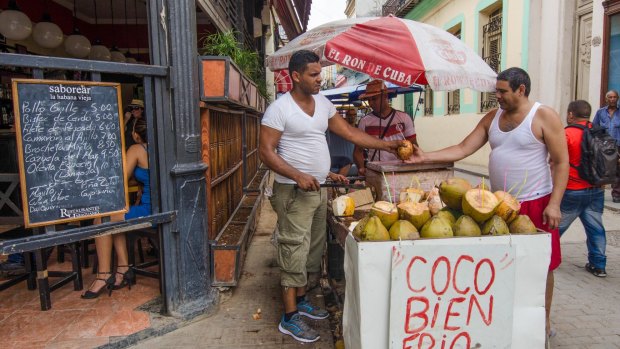
Street vendor sells fresh chilled coconuts on the busy pedestrian street Obispo in the historic La Habana Vieja neighbourhood. Credit: Shutterstock
Havana is more than Hemingway, Fidel, the Mafia and rum – but they are good places to start. The 1959 revolution changed everything for Cuba and Havana. And there are many interesting, if unintended, consequences. First, the 1950s classic American cars – Buicks, Fords, Oldsmobiles, Chevies and Chryslers. They are ubiquitous and an attractive part of the scenery. The yellow Hyundai, Geely and Kia taxis are cheaper, of course – yet nothing in Havana is expensive.
Havana features every style of architecture known to man since about the 1700s, and the photos of crumbling buildings adjacent to refurbished repainted ones are a correct and sorry contemporary record. Cuba has a tropical climate, after all, and buildings deteriorate if not maintained. Among the kaleidoscope of architectural styles, however, the Mafia-built casino hotels of the late 1950s are the most intriguing.
Their survival has everything to do with timing, and the Mob got that badly wrong. The incredibly corrupt President Fulgencio Batista was happy to let American criminals control the high-end tourist industry so long as he got his considerable skim. Santo Trafficante of Tampa and Meyer Lansky – the Cosa Nostra financial guru and leader of its subset the "kosher nostra" – were the key players. It is they who built the hotels.
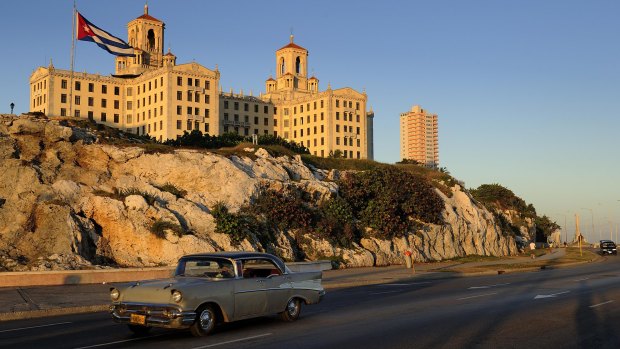
One of Havana's many classic 1950s cars drives past former Mob-owned Hotel Nacional.Credit: Shutterstock
The Mob had enjoyed part ownership of the grand old Hotel Nacional from at least the 1930s. Sitting on an incomparable site overlooking the Bay of Havana, the Nacional famously hosted Lucky Luciano's 1946 Mafia conclave at which Frank Sinatra provided the entertainment. But it was in 1957 and 1958 that the grand new Havana hotels were built – notably the Riviera and the Hilton.
Lansky concentrated his efforts on the 21-storey, 440-room Havana Riviera. He spent lavishly on specially commissioned sculptures inside and out, on original interior designs for the lobby, restaurant, casino and other public rooms – settees and tables, credenzas, screens, light fixtures, chandeliers and so on, all in the Las Vegas 1950s style – and it's all still there, if somewhat fading. In the high-end l'Aiglon restaurant even the flatware, tables and dining chairs are preserved. The swimming pool was grander than Miami's Fontainebleau, its diving tower higher and more spectacular and its poolside cabanas just as exclusive. It's all still there, save the cabanas. The change of name to Habana Riviera has meant little and Meyer Lansky's dream is now a brilliant and enduring example of Miami Modern.
A fading Ginger Rogers starred at the Riviera's official opening on December 10, 1957, and Steve Allen showcased the hotel when his top-rating US TV show broadcast direct from the Riviera on January 19, 1958. The place was booming. By March the new and overbearing 660-room Havana Hilton cried out for attention. Las Vegas authorities felt so threatened by these new Cuban developments that they banned anyone from having an interest in both Nevada and Cuban casinos. So Lansky bought out his pals in the Hotel Nacional, thereby compounding his exposure to Cuba. And then, within the year, in January 1959, it was all over.
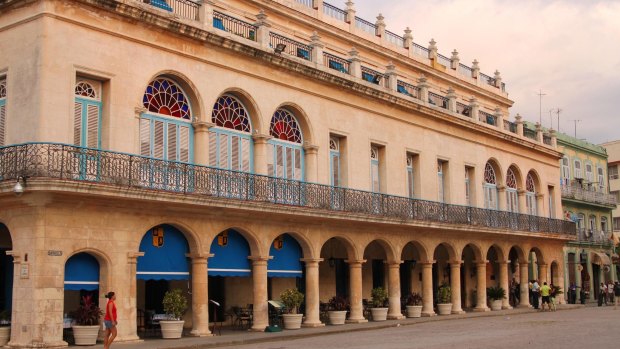
Colonial architecture in Plaza de Armas in Havana Vieja.Credit: Shutterstock
Although Havana was "liberated" on New Year's Day 1959, Fidel kept the capital waiting as he led a celebrated caravan of bearded followers (the "barbudos") across the island from the old capital of Santiago. Arriving in triumph on January 8, he immediately took over the Hilton. Its construction had dominated the Havana skyline for the previous couple of years as a symbol of Yankee imperialism and local corruption; this is probably why Castro made it his headquarters. The barbudos settled into a hotel lobby that stays unchanged to this day. As indeed has the hotel's arrival circle and all the public areas. Only the name is new: the Habana Libre now dominates the quarter.
It was important to remind the people of their past exploitation, and nothing does this better than the Museo de Artes Decorativas, just up the road from the Habana Libre in the once chic Vedado residential quarter. With all but the local synagogue crumbling around it, this former residence of the prominent Gomez family reeks of opulence and wealth: beyond the neoclassical foyer and its expensive bronze sculptures lie rooms decked out in marble and littered with chinoiserie, Meissen porcelain, Murano glass and Aubusson carpets. The villa's courtyards extend seamlessly from the building itself into external spaces suitable for entertaining the likes of the Duke and Duchess of Windsor, as they did.
Over in Habana Vieja ("old Havana") the Museo de la Revolucion is housed in the atmospheric, if now somewhat rundown, former presidential palace. A 1920s building, the museum documents the fall of the old regime, opens the presidential apartments for inspection and fills the erstwhile presidential gardens with revolutionary materiel – tanks, aeroplanes, delivery vans and, most importantly, the Granma, the small vessel that transported Fidel and his fellow revolutionaries from Mexico in 1956. Everyone should visit it.
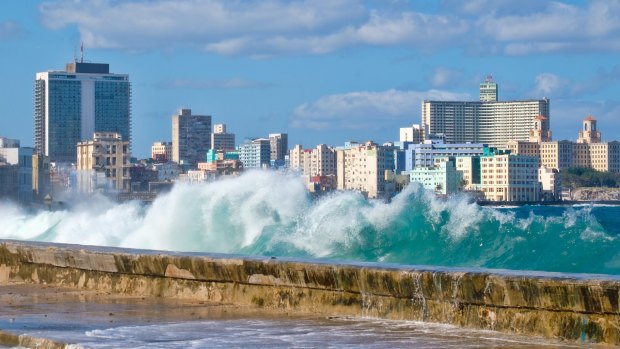
The Havana skyline with waves crashing on the Malecon seawall.Credit: Shutterstock
For it is in Habana Vieja that one finds most that will interest tourists. Havana's "Champs-Elyssée", the Prado, is flanked by decaying palaces but it looks great. Like the nearby shopping street, the Obispo, it is full of tourists and locals alike. You feel safe and you are.
Then there are the wonderful colonial squares, where the rich had their palaces and the church constructed its temples. In contrast to the surrounding streets, they are all in good order. Each has its qualities but the prettiest is undoubtedly the flowering Plaza de Armas, where the splendour and solidity of the governor's baroque palace – the Palacio de los Capitanes Generales – rather begs the question as to why anyone would want to build a new presidential palace. Nearby, the huge Capitolio, inaugurated in 1929, is a wasteful replica of Washington DC's Capitol building – only larger. Sitting on the edge of La Habana Viejo and the decidedly less salubrious central district, the Capitolio provides another example of Cuba's priorities during its "democratic" era; it once housed the Cuban parliament.
This is a communist state. The people are poor but one sees no poverty. The locals look healthy and are seemingly happy. There must be opposition to the regime but it is not evident. Touting is not a problem for the tourist: lifting a hand towards a stop signal together with a polite "no thanks" will put any prospective interlocutor off. There is no obvious prostitution.
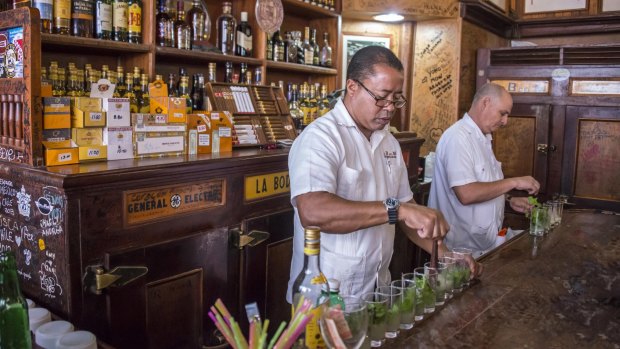
Preparing Havana's signature cocktail, the mojito. Credit: Shutterstock
Cuba is a fertile tropical island, yet the country imports 80 per cent of its food. The public markets for vegetables and meat look horrid. So the economy is not working. Much of the country's economic decline is due to the outrageous US trade boycott, of course, but the rest is the self-inflicted result of failing communism. Yet they are proud. And Yankee dominance has gone forever.
The city runs east-west – from La Habana Vieja in the east, next to the harbour, through Centro Habana to the Vedado in the west and the Miramar district beyond. It lends itself to the flaneur as there seems to be something interesting around every corner. VanDam's plastic folding map La Habana is the perfect companion. Taxis are cheap. Public buses are cheaper still – but they are infrequent and crowded. You can walk through the small Barrio Chino and see vestiges of a Chinatown that once covered 44 city blocks. Much is still there in a new guise of some sort, although the sordid Shanghai Theatre at 205 Zanja – where, according to Graham Greene, "for one dollar and twenty-five cents one could see a nude cabaret of extreme obscenity with the bluest of blue films in the intervals" – is no more. In its place stands a small park featuring a statue of Confucius.
Everyone must walk at least once along the Malecón, the great waterside thoroughfare running east-west which abuts the Bay of Havana and forms the northern border of the city. This is where those seasonal waves break the famous sea wall, where fishermen can contemplate whatever, where the salty air can bring a welcome breeze and where lovers stroll day and night. Key West is just 145 kilometres away over the horizon. One day the ferries will again link Havana with the Florida Keys; for the moment, however, the cruise lines are against it.
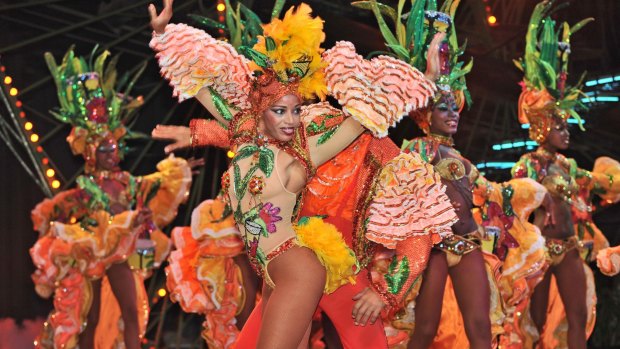
Dancers performing at the Tropicana in Havana.Credit: Shutterstock
Ernest Hemingway is inescapable. He moved to Havana in the 1930s from Key West. The attractive pink Ambos Mundos hotel on Obispo preserves Room 511 where Hemingway wrote some bestsellers, but it is his hilltop estate, Finca La Vigía, about 20 minutes out of town, that must be the key to his love for Cuba. A charming and substantial country villa with wide balconies, a hideaway tower for writing, extensive grounds and a wonderful swimming pool, Finca La Vigía provided the author with a restful sanctuary for his last 20 or so years. Domestic facilities and an array of personal artefacts are in place and on display. The establishment was allegedly given to the state when the author committed suicide in 1961. A more plausible explanation is that the regime simply took it over.
Perhaps the most famous relic of the postwar era is the Tropicana nightclub. Its casino was closed post-revolution but the nightclub lives on – with nightly packed houses of tourists in its glamorous sylvan setting, now in suburbia. Some say the costumes and dance steps haven't changed for 50 years.
Less fortunate is the famous Oriental Park Racetrack. Meyer Lansky's reputation as an expert in running a "clean" casino reached the ears of the military strongman Batista. In late 1937 he invited the diminutive 35-year-old Lansky to revamp the racetrack's two casinos and soon they were relaunched to much fanfare and success. (By 1952, as Cuba's president, Batista had appointed Lansky the country's "adviser on gambling reform".) Oriental Park and its winter season became an important part of North America's thoroughbred racing circuit in the late 1940s and through the 1950s. Fidel did not like gambling, so post-revolution the track struggled until it closed in 1967. Today the complex houses a large government import-export enterprise, sealed off behind the old entrance, its offices occupying the former grandstands and Jockey Club. Oriental Park's history has been lost to the locals with the passage of time and taxi drivers now have to be given directions to find it.
Hemingway's watering holes attract hordes of tourists. His quote – "My mojito in La Bodeguita. My daiquiri in El Floridita." – is almost certainly apocryphal, not least because Hemingway preferred his daiquiris without sugar. Both La Floridita and La Bodeguita del Medio are well worth a visit even though one can get a better and cheaper drink up the road at the excellent Ron Ron. The handsomest of all bars, however, is the newly reconstructed Sloppy Joe's ("the original one in the world"); it's a pity today's service does not match the perfect décor. After thorough research I can report that the aged rum from Santiago is the best to be had, not that there is anything wrong with the common-and-garden Havana Club, and that this delicious beverage should be served straight with a twist of lime either on the rocks or not.
For accommodation many swear by the private casas particulares. Havana is fast becoming one of Airbnb's top sites. Certainly the private restaurants – paladares – can be good: La Terrazza at 309 Prado ("ask for Sergio") and Ivan Chef Gusto are outstanding.
The best hotel is Iberostar's Parque Central. Advertised as five star it is really four, and has everything for my needs: great location, good Wi-Fi and foreign exchange facilities, cheap laundry and a lap pool. The Saratoga is for film stars and more expensive. Soon to come is the Kempinski, which is being created out of the huge old Gomez building on Parque Central, and – best of all – a revitalised Riviera, which Iberostar is to start refurbishing in late 2017.
Nicholas Whitlam's latest book is Four Weeks One Summer, the four weeks in the summer of 1936 when when Hitler was emboldened to plan a new European war (Australian Scholarly Publishing, RRP $44)
TRIP NOTES
MORE
FLY
There are no direct flights from Sydney or Melbourne. Foreigners need a Travel Card. The new US travel restrictions apply to anyone travelling from the US to Cuba, whether a US citizen or not, and this effectively means it is necessary to travel as part of a group. Independent travellers should fly direct from Canada or Mexico, from Europe or South America. The Cuban Embassy in Canberra (02) 6286 8770 issues Travel Cards – but not for entry via the US.
STAY
Hotel Nacional de Cuba see hotelnacionaldecuba.com CUC264 ($335); Iberostar Parque Central iberostar.com $362 or Airbnb Havana airbnb.com
MONEY
Cuba is largely a cash economy. Credit cards are accepted in top hotels but not if the issuer clears through a US bank. ATMs rarely work and there are often long queues at the banks. The CUC – Cuban convertible peso – is the local currency for foreigners. The exchange rate is about 1 CUC = $1.30. Some hotels – such as Iberostar – have efficient foreign exchange services for guests. The exchange rate for US dollars is deliberately unacceptable; travel with euros or Canadian dollars and, because Cuba is cheap, make sure to have plenty of small denominations. Pay in advance on the internet for any major expenses and take cash for other expenses.
Sign up for the Traveller Deals newsletter
Get exclusive travel deals delivered straight to your inbox. Sign up now.